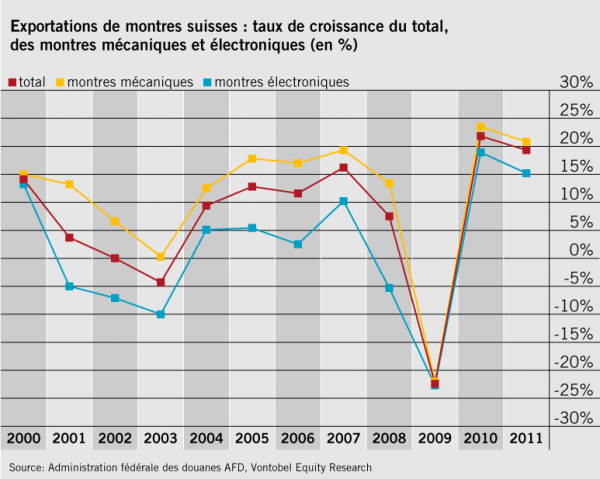In a rarely seen role reversal, that segment of the Swiss watch industry which came close to extinction in the 1970s and 1980s is now its driving force. Indeed, mechanical watches are enjoying almost fairytale fortunes. While the trend isn’t new, a ten-year perspective sheds a different and revealing light on this success story.
Structural change
Export figures for the last twelve financial years (since 2000) show that mechanical watches have grown faster than quartz, and 2011 is no exception. “As previously observed, mechanical watches have progressed more rapidly, gaining 23% while quartz watches increased by 18%,” commented René Weber, an analyst at Zurich-based Bank Vontobel, in a 108-page report on the Swiss watch industry. Mechanically-driven watches accounted for one-fifth of the total number of exported timepieces and almost three-quarters of their value, according to the Federation of the Swiss Watch Industry. With exports bordering on CHF 19.3 billion in 2011, Swiss watchmakers outperformed their previous annual high by 19.2%.
The ratio of mechanical to quartz has also taken an upward turn and at a more than proportional rate. Mechanical and quartz were neck-and-neck (50% each) in 2001. In 2005, mechanical upped its share to 60% then broke through the 70% mark in 2008. Last year mechanical watches notched up 73% of total exports in value terms. All of which equates to an increase of 25 percentage points between 2000 and 2011. To say that watchmaking has undergone a profound structural transformation in barely a decade would be an understatement.

Greater contrast with quartz
Unsurprisingly, total volumes have experienced a similar upswing. At the start of the millennium, production of mechanical watches came to some two and a half million units. Last year, Swiss workshops turned out 6.6 million. In contrast, over the same period the number of electronic watches slipped from 27 million to 23.6 million. Doing the sums, this gives a rise of 160% on the one hand and a drop of just over 10% on the other.
While mechanical timepieces have made a convincing break upward, Weber considers progression by quartz watches to be less clear-cut, both in volume and in value. In 2009, with the global economy embroiled in financial crisis sparked by US subprime losses, exports fell 17.6% in volume whereas price/mix* dropped just 5.2%. This discrepancy adjusted itself in 2010 with volume gaining 17.9% compared with just 1% for price/mix. Last year’s increases in volume (11.8%) and price/mix (4%) were more consistent. Between 2000 and 2011, there have been just five instances of the two rising or falling together. The biggest gap occurred in 2001, when prices increased 8% while quantity lost 12.9%.

Don't give up on quartz
The mechanical segment has proved more stable. Over the twelve financial years in question, volume and price/mix have increased or decreased together on seven occasions. The gap between the two was widest over the last two years, due in part to fluctuating exchange rates and commodities prices. Thus in 2010, volume shot up 32% at the same time as price/mix lost 7.8%. The following year, volume went up 25% while price/mix shed 4%.
The conclusion seems to stare us in the face: despite the dearth of corresponding movements, watchmakers should put their money on mechanical. Which would be a grave error. Such variety of products, the choice which the end customer enjoys, is part of Swiss watchmaking’s appeal. Furthermore, the two categories don’t necessarily address the same audience. This potpourri is a means of winning new customers, both men and women, and seducing a younger clientele with more affordable models, many of which are quartz. Wearing a watch is a habit to be acquired from an early age. This is how watchmaking prepares its future and lays the foundations for its continued success.
*Price/mix effect measures how changes in revenue are spread across sales of a company’s different products. The effect is favourable when increased revenue is the result of increased sales of the most profitable products. An unfavourable effect means that sales focused on the less profitable products to the detriment of margins.










